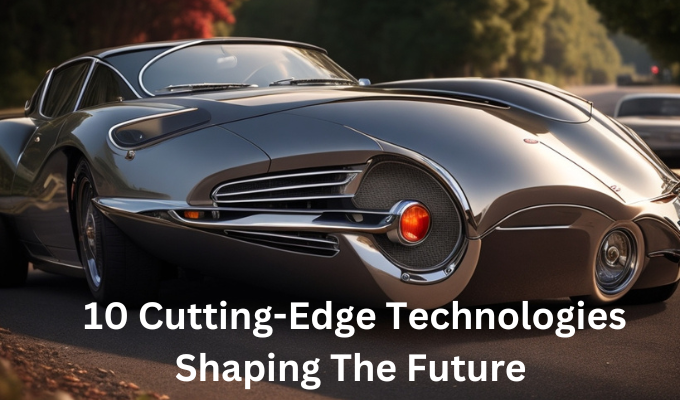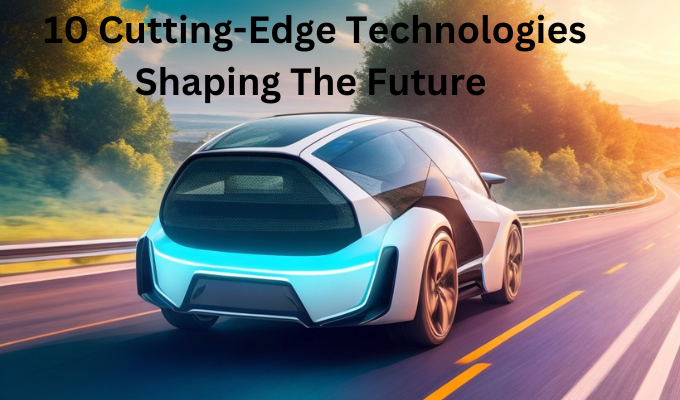10 Cutting-Edge Technologies Shaping The Future
Technology is advancing at an unprecedented pace, and its impact is felt in various industries. The automotive sector, in particular, is witnessing remarkable innovations that are reshaping the future of transportation.
In this article, we will explore 12 cutting-edge technologies that are driving the automotive industry forward.
1. Electric Vehicles (EVs)
Electric vehicles have gained significant traction in recent years. With advancements in battery technology, EVs offer longer driving ranges and faster charging times. They provide a cleaner and more sustainable alternative to traditional gasoline-powered cars, contributing to reduced emissions and a greener environment.
2. Autonomous Driving
Autonomous driving technology aims to revolutionize transportation by enabling vehicles to operate without human intervention. Through the use of advanced sensors, artificial intelligence, and machine learning algorithms, autonomous vehicles can perceive their surroundings and make decisions accordingly. This technology holds great promise in terms of improving road safety and optimizing traffic flow.
3. Connectivity and IoT Integration
Connected cars leverage the power of the Internet of Things (IoT) to enhance the driving experience. By connecting vehicles to the internet, drivers can access real-time traffic information, receive over-the-air software updates, and enjoy a range of connected services. IoT integration also enables seamless communication between vehicles, infrastructure, and other smart devices.
4. Advanced Driver Assistance Systems (ADAS)
ADAS technologies are designed to assist drivers and enhance safety on the road. These systems include features such as lane-keeping assist, adaptive cruise control, automatic emergency braking, and blind-spot monitoring. ADAS technologies act as co-pilots, helping to prevent accidents and mitigate the impact of potential collisions.
5. Vehicle-to-Vehicle (V2V) Communication
V2V communication enables vehicles to exchange information with each other, enhancing safety and traffic efficiency. By sharing data about their speed, position, and intentions, vehicles can anticipate and respond to potential hazards. This technology enables faster reaction times and facilitates cooperative driving scenarios.
6. Augmented Reality (AR) Displays
AR displays provide an immersive and intuitive way to interact with a vehicle's features and information. By overlaying digital content onto the real world, drivers can access navigation instructions, vehicle performance data, and alerts without diverting their attention from the road. AR technology enhances safety and convenience within the driving experience.
7. Advanced Materials and Lightweight Design
The use of advanced materials, such as carbon fiber composites and lightweight alloys, allows for the construction of lighter and more fuel-efficient vehicles. These materials offer high strength-to-weight ratios, reducing energy consumption and emissions while maintaining structural integrity. Lightweight design is crucial for maximizing the efficiency and range of electric vehicles.
8. Vehicle Electrification and Hybridization
Apart from fully electric vehicles, hybrid, and plug-in hybrid vehicles are playing a significant role in the transition to greener transportation. These vehicles combine an internal combustion engine with electric motors and batteries, offering improved fuel efficiency and reduced environmental impact. Vehicle electrification and hybridization provide flexible solutions to cater to different consumer needs and infrastructure availability.
9. 3D Printing in Automotive Manufacturing
3D printing, also known as additive manufacturing, is revolutionizing the automotive manufacturing process. It allows for the production of complex geometries, customization, and rapid prototyping. 3D printing reduces waste, lowers production costs, and enables on-demand manufacturing of spare parts, making the automotive industry more agile and sustainable.
10. Artificial Intelligence (AI) in Vehicle Systems
Artificial Intelligence (AI) is making significant strides in various industries, and the automotive sector is no exception. The integration of AI in-vehicle systems is transforming the way we drive and interact with our cars. In this section, we will explore how AI is revolutionizing the automotive industry.
One of the key areas where AI is making a substantial impact is autonomous driving. AI algorithms, powered by machine learning and deep neural networks, enable vehicles to perceive their surroundings, make real-time decisions, and navigate complex road conditions. By analyzing data from sensors such as cameras, radar, and LIDAR, AI systems can detect and classify objects, predict their behavior, and plan appropriate actions.
AI also plays a crucial role in advanced driver assistance systems (ADAS). These systems rely on AI algorithms to provide features like lane-keeping assist, adaptive cruise control, and automatic emergency braking. By continuously monitoring the environment and analyzing sensor data, AI systems can alert drivers to potential dangers and assist in avoiding collisions.
Another area where AI is making waves is in natural language processing (NLP) and voice recognition. AI-powered virtual assistants, such as Apple's Siri, Amazon's Alexa, and Google Assistant, are being integrated into vehicles, allowing drivers to control various functions through voice commands. Drivers can make hands-free phone calls, adjust climate settings, get directions, and even interact with other connected devices seamlessly.
AI is also driving advancements in predictive maintenance and vehicle health monitoring. By analyzing historical data, sensor readings, and performance metrics, AI algorithms can identify potential issues in a vehicle before they become major problems. This proactive approach helps in preventing breakdowns, reducing maintenance costs, and maximizing the lifespan of components.
Furthermore, AI is being used in improving the overall user experience inside the vehicle. AI systems can learn driver preferences, such as a seat and mirror positions, climate control settings, and entertainment preferences, and automatically adjust them based on individual profiles. This personalized experience enhances comfort and convenience for the driver and passengers.
In the field of automotive manufacturing, AI is streamlining production processes and improving efficiency. AI-powered robots and automation systems are being used for tasks such as assembly, quality control, and logistics. These systems can perform repetitive tasks with precision and speed, leading to higher production rates and improved overall product quality.
The integration of AI in-vehicle systems also raises cybersecurity concerns. As vehicles become more connected and rely heavily on software and data, protecting against cyber threats is of paramount importance. AI algorithms can help detect and prevent cyberattacks by analyzing patterns, identifying anomalies, and implementing robust security measures.
In conclusion, AI is revolutionizing the automotive industry by enabling autonomous driving, enhancing safety through advanced driver assistance systems, improving user experience, optimizing manufacturing processes, and addressing cybersecurity challenges. As AI continues to evolve, we can expect even more exciting developments in the future, making our vehicles smarter, safer, and more connected than ever before.



